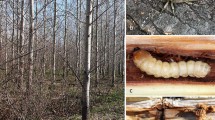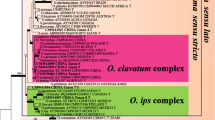Abstract
The bark beetle Ips typographus has different hibernation environments, under the bark of standing trees or in the forest litter, which is likely to affect the beetle-associated fungal flora. We isolated fungi from beetles, standing I. typographus-attacked trees, and forest litter below the attacked trees. Fungal identification was done using cultural and molecular methods. The results of the two methods in detecting fungal species were compared. Fungal communities associated with I. typographus differed considerably depending on the hibernation environment. In addition to seven taxa of known ophiostomoid I. typographus-associated fungi, we detected 18 ascomycetes and anamorphic fungi, five wood-decaying basidomycetes, 11 yeasts, and four zygomycetes. Of those, 14 fungal taxa were detected exclusively from beetles that hibernated under bark, and six taxa were detected exclusively from beetles hibernating in forest litter. The spruce pathogen, Ceratocystis polonica, was detected occasionally in bark, while another spruce pathogen, Grosmannia europhioides, was detected more often from beetles hibernating under the bark as compared to litter. The identification method had a significant impact on which taxa were detected. Rapidly growing fungal taxa, e.g. Penicillium, Trichoderma, and Ophiostoma, dominated pure culture isolations; while yeasts dominated the communities detected using molecular methods. The study also demonstrated low frequencies of tree pathogenic fungi carried by I. typographus during its outbreaks and that the beetle does not require them to successfully attack and kill trees.


Similar content being viewed by others
References
Adams AS, Six DL, Adams SM, Holben WE (2008) In vitro interactions between yeasts and bacteria and the fungal symbionts of the Mountain Pine beetle (Dendroctonus ponderosae). Microb Ecol 56:460–466
Altschul SF, Madden TL, Schäffer AA, Zhang J, Zhang Z, Miller W, Lipman DJ (1997) Gapped BLAST and PSI-BLAST: a new generation of protein database search programs. Nucleic Acids Res 25:3389–3402
Annila E (1969) Influence of temperature upon the development and voltinism of Ips typographus L. (Coleoptera, Scolytidae). Annales Zoologici Fennici 6:161–208
Austara O, Pettersen H, Bakke A (1977) Bivoltinism in Ips typographus in Norway, and winter mortality in second generation. Meddelelser fra Norsk Institutt for Skogforskning 33:269–281
Bakys R, Vasaitis R, Barklund P, Ihrmark K, Stenlid J (2009) Investigations concerning the role of Chalara fraxinea in declining Fraxinus excelsior. Plant Pathol . doi:10.1111/j.1365-3059.2008.01977.x
Castello JD, Shaw CG, Furniss MM (1976) Isolation of Cryptoporus volvatus and Fomes pinicola from Dendroctonus pseudotsugae. Phytopathology 66:1431–1434
Christiansen E, Bakke A (1988) The spruce bark beetle of Eurasia. In: Berryman AA (ed) Dynamics of forest insects populations. Plenum Press, New York, pp 479–503
Christiansen E, Solheim H (1990) The bark beetle-associated blue-stain fungus Ophiostoma polonicum can kill various spruces and Douglas fir. Eur J For Pathol 20:436–446
Colwell RK, Coddington JA (1994) Estimating terrestrial biodiversity through extrapolation. Phil Trans R Soc Lond B 345:101–118
Dickie IA, Xu B, Koide RT (2002) Vertical niche differentiation of ectomycorrhizal hyphae in soil as shown by T-RFLP analysis. New Phytol 156:527–535
Furniss MM, Solheim H, Christiansen E (1990) Transmission of blue-stain fungi by Ips typographus (Coleoptera: Scolytidae) in Norway spruce. Ann Entomol Soc Am 83:712–716
Gardes M, Bruns TD (1993) ITS primers with enhanced specifity for basidiomycetes- application of the identification of mycorrhizae and rusts. Mol Ecol 2:113–118
Harding S (1989) The influence of mutualistic blue-stain fungi on bark beetle population dynamics. Doctoral thesis, Royal Veterinary and Agricultural University of Denmark, Copenhagen
Harding S (1995) Fungal associates of Ips typographus L. in Denmark – occurrence, frequency and pathogenicity. In: Bark Beetles, Blue Stain Fungi, and Conifer Defence Systems (Christiansen E, ed.). Norwegian Forest Research Institute, As. Aktuelt fra Skogforsk 6-95: pp 36
Harrington TC (2005) Ecology and evolution of mycophagous bark beetles and their fungal partners. In: Vega FE, Blackwell M (eds) Insect–fungal associations: ecology and evolution. New York, Oxford University Press, pp 257–142
Harrington TC, Furniss MM, Shaw CG (1981) Dissemination of Hymenomycetes by Dendroctonus pseudotsugae (Coleoptera: Scolytidae). Phytopathology 71:551–554
Hedgren PO, Schroder LM (2004) Reproductive success of the spruce bark beetle Ips typographus (L.) and occurrence of associated species: a comparison between standing beetle-killed trees and cut trees. For Ecol Manag 203:241–250
Horntvedt R, Christiansen E, Solheim H, Wang S (1983) Artificial inoculation with Ips typographus-associated blue-stain fungi can kill healthy Norway spruce trees. Meddelelser fra Norsk Institutt for Skogforskning 38:1–20
Hsiau PTW, Harrington TC (2003) Phylogenetics and adaptations of basidiomycetous fungi fed upon by bark beetles (Coleoptera: Scolytidae). Symbiosis 34:111–131
Ihaka R, Gentleman R (1996) R: A language for data analysis and graphics. J Comput Graph Stat 5:299–314
Jankowiak R (2005) Fungi associated with Ips typographus on Picea abies in southern Poland and their succession into the phloem and sapwood of beetle-infested trees and logs. Forest Pathol 35:37–55
Jankowiak R, Hilszczanski J (2005) Ophiostomoid fungi associated with Ips typographus L. on Picea abies (L.) H.Karst. and Pinus sylvestris L. in north-eastern Poland. Acta Societatis Botanicorum Poloniae 74:345–350
Jonsson AM, Harding S, Barring L, Ravn HP (2007) Impact of climate change on the population dynamics of Ips typographus in southern Sweden. Agric For Meteorol 146:70–81
Kim JJ, Allen EA, Humble LM, Breuil C (2005) Ophiostomoid and basidiomycetous fungi associated with green, red, and grey lodgepole pines after mountain pine beetle (Dendroctonus ponderosae) infestation. Can J For Res 35:274–284
Kirisits T (2004) Fungal associates of European bark beetles with special emphasis on the Ophiostomatoid fungi. In: Lieutier F, Day KR, Battisti A, Gregoire J-C, Evans HF (eds) Bark and wood boring insects in living trees in Europe, a synthesis. Kluwer Academic Publishers, London, pp 181–235
Kirschner R (2001) Diversity of filamentous fungi in bark beetle galleries in central Europe. In: Misra K, Lichtwardt RW (eds) Trichomycetes and other fungal groups. Commemoration Volume, Science Publishers Inc, Enfield, pp 175–196
Krokene P, Solheim H (1996) Fungal associates of five bark beetle species colonizing Norway spruce. Can J For Res 26:2115–2122
Landeweert R, Leeflang P, Kuyper TW, Hoffland E, Rosling A, Wernars K, Smit E (2003) Molecular identification of ectomycorrhizal mycelium in soil horizons. Appl Environ Microbiol 69:327–333
Långström B, Lindelöw Å, Schroeder LM, Björklund N, Öhrn P (2009) The spruce bark beetle outbreak in Sweden following the January-storms in 2005 and 2007. In: Insects and Fungi in Strom Areas, (ed) A. Kunca & M. Zubrik, Proceedings of workshop of IUFRO Working Party 7.03.10, September 15-19, Strbske Pleso, Slovakia, National Forest Centre
Lee S, Kim JJ, Breuil C (2006) Diversity of fungi associated with the mountain pine beetle, Dendroctonus ponderosae and infested lodgepole pines in British Columbia. Fungal Diversity 22:91–105
Lim YW (2005) Determining fungal diversity on Dendroctonus ponderosae and Ips pini affecting logepole pine using cultural and molecular methods. Fungal Diversity 19:1560–2745
Lindahl BD, Ihrmark K, Boberg J, Trumbore SE, Högberg P, Stenlid J, Finlay RD (2007) Spatial separation of litter decomposition and mycorrhizal nitrogen uptake in a boreal forest. New Phytol 173:611–620
Magurran AM (1998) Ecological diversity and its measurement. Princeton University Press, Princeton
Martin KJ, Rygiewicz PT (2005) Fungal-specific PCR primers developed for analysis of the ITS region of environmental DNA extracts. BMC Microbiology 5:28
Mathiesen-Käärik A (1953) Eine Übersicht über die gewöhnlichsten mit Borkenkäfern assoziierten Bläuepilze in Schweden und einige für Schweden neue Bläuepilze. Meddelanden från Statens Skogsforskningsinstitut 43:68–74
McCall J (1996) Comparing proportions and testing for independence in: statistics: a guide for therapists. Butterworth-Heinemann, Oxford, pp 121–136
O’Brien HE, Parrent JL, Jackson JA, Moncalvo J-M, Vilgalys R (2005) Fungal community analysis by large-scale sequencing of environmental samples. Appl Environ Microbiol 71:5544–5550
Pettersen H, Austara O (1975) Overwintering conditions for Ips typographus L. (Col., Scolytidae. Meddelelser fra Norsk Institutt for Skogforskning 31:569–580
Pettey TM, Shaw CG (1986) Isolation of Fomitopsis pinicola from in-flight bark-beetles (Coleoptera: Scolytidae). Can J Bot 64:1507–1509
Rice AV, Thormann MN, Langor DW (2008) Mountain pine beetle-associated blue-stain fungi are differently adapted to boreal temperatures. Forest Pathol 38:113–123
Salle A, Monclus R, Yart A, Garcia J, Romary P, Lieutier F (2005) Fungal flora associated with Ips typographus: frequency, virulence, and ability to stimulate the host defence reaction in relation to insect population levels. Can J For Res 35:365–373
Sandnes A, Solheim H (2002) Variation in tree size and resistance to Ceratocystis polonica in a monoclonal stand of Picea abies. Scand J Forest Res 17:522–528
Six DL, Bentz BJ (2003) Fungi associated with the North American spruce beetle, Dendroctonus rufipennis. Can J For Res 33:1815–1820
Six DL, Bentz BJ (2007) Temperature determines symbiont abundance in a multipartite bark beetle-fungus ectosymbiosis. Microb Ecol 54:112–118
Solheim H (136) Fungal succession in sapwood of Norway spruce infested by the bark beetle Ips typographus. Eur J For Pathol 22:136–148
Solheim H (1988) Pathogenicity of some Ips typographus-associated blue-stain fungi to Norway spruce. Meddelelser fra Norsk Institutt for Skogforskning 38:1–20
Solheim H (1991). Ecological aspects of fungi associated with the spruce bark beetle I. typographus, with special emphasis on fungal invasion of Norway spruce sapwood and the role of the primary invader Ophiostoma polonicum. Doctoral thesis, Agricultural University of Norway, Ås
Solheim H (1993) Fungi associated with the spruce bark beetle Ips typographus in an endemic area in Norway. Scand J Forest Res 8:118–122
Solheim H, Krokene P (1998) Growth and virulence of Ceratocystis rufipenni and three blue-stain fungi isolated from the Douglas-fir beetle. Can J Bot 76:1763–1769
Stenlid J (1985) Population structure of Heterobasidion annosum as determined by somatic incompatibility, sexual incompatibility, and isoenzyme patterns. Can J Bot 63:2268–2273
Svensson L (2007) Övervakning av insektsangrepp. Slutrapport från Skogsstyrelsens regeringsuppdrag. Meddelande 1-2007.Skogsstyrelsens förlag, Jönköping, pp 143
Vasiliauskas R, Menkis A, Finlay RD, Stenlid J (2007) Wood-decay fungi in fine living roots of conifer seedlings. New Phytologist 174:441–446
Viiri H (2002) Interactions between host trees and fungi associated with the spruce bark beetle (I. typographus). Doctoral Thesis, The Finnish Forest Research Institute Research Papers 864)
White TJ, Bruns T, Lee S, Taylor J (1990) Amplification and direct sequencing of fungal ribosomal RNA genes for phylogenethics. In: Innis MA, Gelfand DH, Sninsky JJ, White TJ (eds) PCR protocols: a guide to methods and applications. Academic Press, San Diego, pp 315–322
Acknowledgments
This study was financially supported by the Swedish Research Council for Environment, Agricultural Sciences and Spatial Planning (FORMAS) and by the Swedish Energy Agency (STEM). We thank Prof. Halvor Solheim for providing reference isolates of Ips typographus-associated ophiostomoid fungi and Petra Fransson for reading and commenting on the manuscript.
Author information
Authors and Affiliations
Corresponding author
Rights and permissions
About this article
Cite this article
Persson, Y., Vasaitis, R., Långström, B. et al. Fungi Vectored by the Bark Beetle Ips typographus Following Hibernation Under the Bark of Standing Trees and in the Forest Litter. Microb Ecol 58, 651–659 (2009). https://doi.org/10.1007/s00248-009-9520-1
Received:
Accepted:
Published:
Issue Date:
DOI: https://doi.org/10.1007/s00248-009-9520-1




